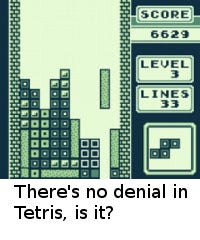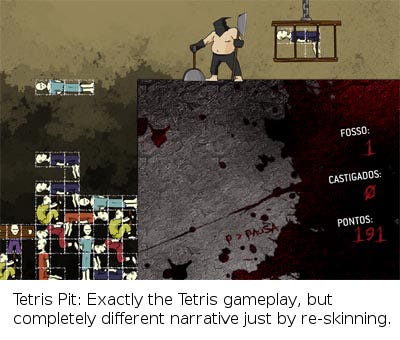
Featured Blog | This community-written post highlights the best of what the game industry has to offer. Read more like it on the Game Developer Blogs or learn how to Submit Your Own Blog Post
The Myth of the Monomyth
The "Hero's Journey" is a narrative pattern we have adopted from the film industry. Since then we try to create our narratives around it. I will explain why this is nonsense. Games create hero's journeys all by themselves - or they wouldn't be games.

This is the story of a long and serious error for which I plead guilty and which I would like to cite as an example that we cannot accept anything as proven in our art form: It's about the monomyth as a narrative paradigm in computer games.
Joseph Campbell's hero's journey, which he himself described as a monomyth, i.e. the actions of a single figure within a narrative, has been regarded as the narrative structure of our art form since the 1990s at the latest.
It is based on the popularity Campbell gained in America in the late 1970s and 1980s, mainly through the first three Star Wars films, all of which were written according to Campbell's hero's journey concept. And so it's understandable that the great Lucas Arts adventures were influenced by it - and they actually spread to the entire industry. Wherever there was a story to tell in the game, the monomyth was not far away.
Today I still lose potential customers to whom I answer the question about the hero's journey: "It's there. At least in parts. But I prefer to aim for total experience." Some publishers want the hero's journey for their documents. They do not trust a development which - as I will show - has a broader approach. They are a little like those of my generation who still don't trust a song that isn't dominated by distorted electric guitars.
I assume here that Campbell's research results are basically known, and I will only repeat them where special parts of them are necessary for coherence. The Campbell formula was adopted, trivialized, misunderstood and simplified in Hollywood after George Lucas. Today you'll have a hard time finding a single Hollywood movie not stultified by using this formula. And unfortunately this at least in parts also happened in our industry.
Getting up in the morning is a complete hero's journey
It's not Campbell's fault, though. Campbell was a mythologist, a much read and widely traveled person, who collected people's myths and eventually found out that they - in many and very interesting variations - in all known cultures follow this one narrative pattern, which he then called monomyth. And he also found out why this pattern exists. What Campbell described is a basic psychological pattern of human thought. We constantly encounter this hero's journey in everyday life. Every day we not only complete a monomyth, but a whole mythology. Getting up in the morning, taking a shower and going to work: this is a complete hero's journey. For some people even simple tooth brushing is one. Not to mention a visit to the dentist; or the spear-armed hunt for the leopard as an entrance examination into the group of adults of a tribe. Having a problem, rather doing something else, overcoming yourself and completing the task: this has been everyday life and life experience for hundreds of thousands of years. We are the heroes in this, and the stories we tell only exaggerate them a little. The best hunter got the most beautiful woman, the cliche says. And the best narrator around the campfire got the second most beautiful. Thus the toothbrush became a dragon.
.jpg/?width=189&auto=webp&quality=80&disable=upscale) Into this basic psychological pattern, as already mentioned above, further basic constants are woven, which Campbell named archetypes after C.G.Jung. The Hero is such a basic constant, the Mentor, the Herald, the Threshold Guardian, the Shadow, and many more. I'm not going to explain them here, everybody can read them up. What is important in my context is that in the better, more interesting stories these archetypes remain exactly that: archetypes - and are not degenerated into stereotypes. Not every mentor has to be a grandpa with a white beard, not every shadow has to be dark.
Into this basic psychological pattern, as already mentioned above, further basic constants are woven, which Campbell named archetypes after C.G.Jung. The Hero is such a basic constant, the Mentor, the Herald, the Threshold Guardian, the Shadow, and many more. I'm not going to explain them here, everybody can read them up. What is important in my context is that in the better, more interesting stories these archetypes remain exactly that: archetypes - and are not degenerated into stereotypes. Not every mentor has to be a grandpa with a white beard, not every shadow has to be dark.
As a tool, I personally have always regarded the hero's journey more as a control authority. Especially when identifying perceived weaknesses in my stories, it has occasionally done a good job. But if I'm honest, I stopped using it as a tool around 2008.
Speaking of tools, much that is taken for granted today did not exist 10 or 15 or more years ago: detailed animations of bodies and faces? Dynamic play with light and shadow? Any number of sound sources for convincing world acoustics in 3D? The list of things that were dreams of the future at that time is long. And every new narrative tool was highly welcome and was seen as the key to a new world. The monomyth seemed to be such a tool 25 years ago. And for many years it remained a kind of philosopher's stone of storytelling in games. This is not an excuse, but an explanation. If all you have is a hammer ...
Just as all sound is music, all play is adventure
In principle not much was even wrong with it, but in a somewhat complicated way then actually everything. That is, because you hardly ever need it at all in games. And there is a simple reason for this: games don't need it, because there can't be a game without hero's journey. A game without a hero's journey is an aesthetic impossibility, just as I cannot write music without sounds. Some smartass will now mention John Cage, but he just declared the ambient sounds as music for 4 minutes and 33 seconds! Even in absolute silence you hear your blood pumping through your veins. There are always sounds - and no game exists without the hero's journey, because just as getting up in the morning has the structure of a hero's journey, so the act of playing already inherently and inevitably has the structure of a hero's journey.
The act of playing itself works with this structure: Games generate at least important and as such recognizable parts of a hero's journey for the player from their mechanics and the player's interaction with it. Games - as opposed to books, movies, music and every other non-interactive art form - are designed predominantly as a series of challenges (Sid Meier's famous quote comes to mind), and overcoming these challenges is their profession. Now the monomyth itself is also about a series of challenges - and there is even a pre-designed boss monster part of this structure: the Shadow. The question about the monomyth, the hero's journey in a game can therefore be answered immediately and without further verification with: "It exists".
The question then only remains to clarify to what extent the movement of bad news, denial, acceptance of the task, entry into the foreign world of challenge and its final mastery can also be found in the mechanics of a game - and how this movement must be narrated from the game mechanics so that it is perceived as a good narrative. And that is exactly the connection that we did not recognize 20 years ago. We wanted to determine the narrative like authors. We could not yet acknowledge the authorship of the game mechanics. We didn't trust it - and probably we were too vain. Or afraid of becoming unemployed...
 But hindsight is 20/20: for where is there something like the hero's denial to begin his journey in, let's say, a game of Tetris? Isn't it the case that even on a metaphorical level, ontology and logic would have to be tried far beyond their respective predetermined breaking points to find something like this? There is no denial within Tetris, is there?
But hindsight is 20/20: for where is there something like the hero's denial to begin his journey in, let's say, a game of Tetris? Isn't it the case that even on a metaphorical level, ontology and logic would have to be tried far beyond their respective predetermined breaking points to find something like this? There is no denial within Tetris, is there?
At least there is the denial to start the game at all. There's this moment when you might think, "Wow, others are so good with the game, I really don't want to embarrass myself here!" (I have a severe fear of playing in public. Is there a psychological term for this? Ludo-Agoraphobia?)
By only looking at the act of playing and ignoring that it is by nature embedded in a more complex plot, which begins before you even start the computer, we could not correctly identify the hero's journey in our art form. We nearly always only looked at a part of it - and therefore did not recognize it. We didn't see the forest for the trees. We could not see that playing Tetris actually resembled a classic tragedy. That the game not only had a denial, but is in fact all denial! Playing it is a denial to acknowledge the inevitable catastrophe that is waiting for you - and to stand in its way until your own demise. The difference to the murderous madness of a Macbeth is more semantic than structural. I'll get back to this.
Parts of the hero's journey that occur when dealing with a game thus might takes place outside of this game. The first act of the hero's journey, which is about departure, most often at least in parts takes place outside of the virtual world. The decision to start the game at all is the departure (or better: a departure; because the monomyth allows for many different kinds of departure: Bilbo sets off - very hastily - but also L. B. Jefferies in Hitchcock's "Rear Window", although he never leaves his apartment). Nevertheless, of course this departure, the decision to start the game in the first place, is part of the gaming experience - and we didn't see that through at the time. So we thought we had to make an entire hero's journey for every game. And we did. And that wasn't always good for the game.
The hero's journey of playing is world-spanning
So we see: The monomyth of the player as the adventure-experiencing instance is world-spanning. I used to teach my students that the first act of a game story has to be pointed at at least during the intro. I would like to distance myself explicitly from this. It's nonsense. As a designer, I can take into account the player's fear of the game, the inhibition of starting it at all (or paying money for it to start with), and use it for the gaming experience. Just as I can legitimately let the game itself end with the stage of the innermost cave - and actually let the players experience the whole third act inside our physical world. What they do at the dinner table with what they have experienced in the game, I do not have to tell in the game. We want our games to mean something for the player - so we should treat them as adults who can work out that meaning on their own! For the players it will thus become part of their story. For that is what makes an interactive art form: the recipient is its hero. It's their story they tell themselves. We as authors should accept that very often we have little to no business during act 1 and 3 just because they belong to the wold of the player - and in case of doubt we should just shut up.
This insight is important because it removes a fundamental error. However, for me as a narrator this is not too much of a gain, because knowing that game mechanics have narrative quality is one thing. Becoming able to develop them into a convincing narrative is something completely different. The reason is: As an author, I can't develop the narrative on my own. This requires mechanics, graphic designers and sound artists. Yet it might help to know that it does not require a monomyth!
Unfortunately, too many designers still believe that if only mechanics and story use the same setting, the thing with the game story will somehow fit. I can just as well call a tailor and say: "I'm a man with four limbs, 1.83 tall and 77 kilos: Build me a suit." It's going to fit somehow. With an emphasis on "somehow".
Most important for a well elaborated game narrative is not the story itself, the brainchild of the author, but that the other world the players enter in the game actually fulfills two conditions:
it must be credible, have coherent rules and
it must be made for the player as an individual.
The other world of the game is supposed to confront me with challenges that have something to do with me. Otherwise they're not even challenges. There must be something about a game I'm interested in. And nothing interests me that has nothing to do with me, even if I am not aware of the fact or the reasons for it - and even if all of this remains unclear after a long reflection. There's a hole in me that a game has to fill, or I won't play it. And this hole in me, it is understood by Campbell's shadow only too well.
If we only make a really good narrative of the second act, make the laws of the game the laws of the shadow that rules the game world; and if that shadow then clicks inside of the player, snaps into place, fills the hole and means something: then we have narratively fulfilled our task. And of course this is much less complex and easier to derive from the conflict potential of the game mechanics than a complete three-act structure with all its additional complexities pushed down the gameplay's throat!
But that doesn't mean I can't write three acts if it fits the dramaturgy of the gameplay well. Many, even most stories have more than one monomyth. Frodo experiences at least five during his travels through Middle-earth (and I'm not talking about him brushing his teeth here...). And many gameplays are complex enough, staged enough to support more than one act.
Gameplay is the monkey, that doesn't even need a typewriter!
So I can place one, several or even many complete monomyths, hero's journeys in a game. But the bottom line is: I don't have to! A good mechanics that is neatly narrated will always create a good story when the game is made for me. We've been asking ourselves the question: If we want to get away from purely predefined branching of a story (as Telltale still does today), if we want to do parametric storytelling: how can we make sure that the story told interactively is interesting? We didn't trust the gameplay as narrators back then. We thought it would take us, the writers.
 Hubris. Pure hubris. Yeah, it's true: Sometimes you need us as writers. Above all, however, we are needed as narrators. That's different. A graphic skin can already narrate and turn a game completely around. Look at Tetris and Tetris Pit. The exact same mechanics, different graphic and sound result in a completely different game - and the realization that the attempt to conceal one crime with another leads to disaster. The tragedy, which only becomes visible in Tetris as an abstract interpretation, becomes apparent in Tetris Pit. And it is closely related to Macbeth, without any author adding a single word. If gameplay was a monkey, it wouldn't even need a typewriter to become Shakespeare.
Hubris. Pure hubris. Yeah, it's true: Sometimes you need us as writers. Above all, however, we are needed as narrators. That's different. A graphic skin can already narrate and turn a game completely around. Look at Tetris and Tetris Pit. The exact same mechanics, different graphic and sound result in a completely different game - and the realization that the attempt to conceal one crime with another leads to disaster. The tragedy, which only becomes visible in Tetris as an abstract interpretation, becomes apparent in Tetris Pit. And it is closely related to Macbeth, without any author adding a single word. If gameplay was a monkey, it wouldn't even need a typewriter to become Shakespeare.
We have to learn to interpret as narrative designers, to find out how to get from the abstract dynamics of an extensive mechanics to an analysis of their inherent dramaturgy. The goal must be the concretization and emotionalization of the game core, not just a pretty packaging that has nothing or little to do with the core of the game.
The dramaturgy of the game mechanics is the source of our stories. Graphics, sound and yes, words are our most important tools for narrative. The hero's journey is not. It is a structure that is experience - and defining and subsequently achieving that experience is the goal of our game design. But we won't make it more effective if we add a second, pretentiously stacked on top of the already existing experience of the gameplay that will inevitably turn into a hero's journey anyway.
We as narrative designers still have a whole language to learn and to invent, a language whose syllables are game mechanics, whose words are formulated in the dynamic interaction of these mechanics, whose sentences only become complete through the semantic levels of image, language and sound - and whose stories we can only tell in a truly artistic way once we have learned to master this language - undistracted by foreign structures that don't apply.
So there's a little more to do on our journey to learn our craft. I have the feeling, we're not even yet in act 2! But we're closing in.
Read more about:
Featured BlogsAbout the Author(s)
You May Also Like







.jpeg?width=700&auto=webp&quality=80&disable=upscale)








